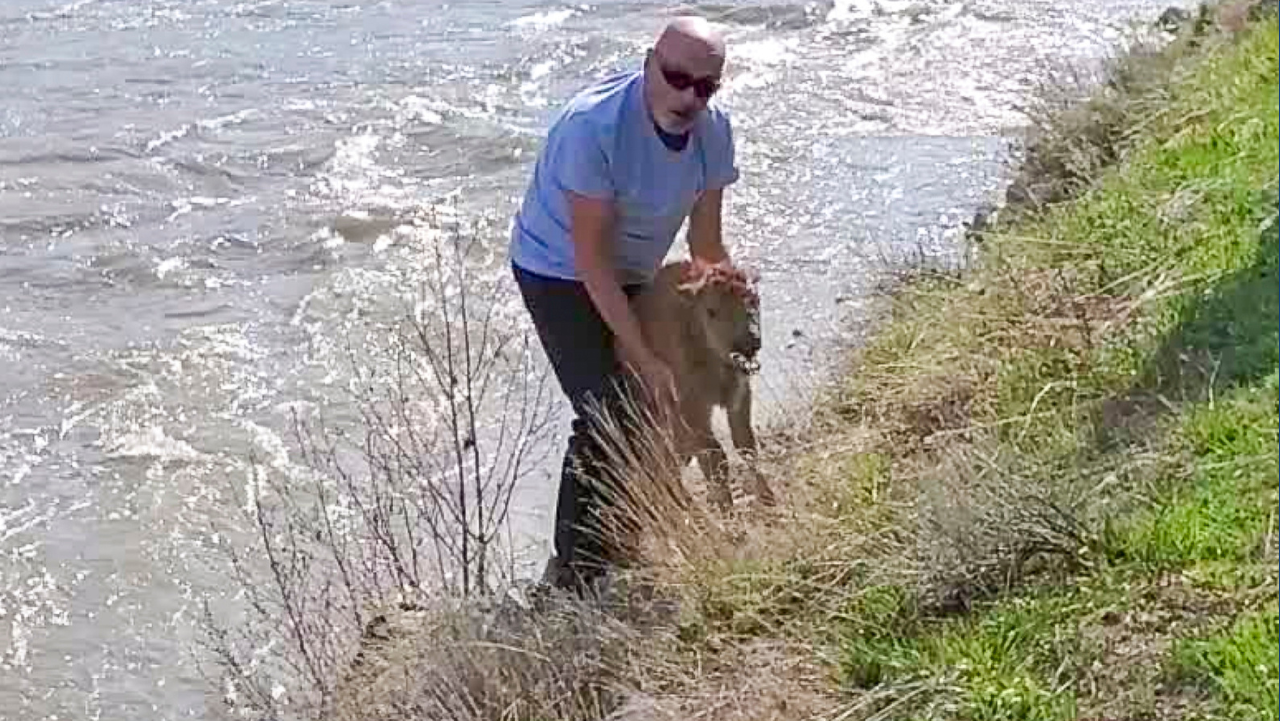Yellowstone National Park continues to search for the man involved in an incident with a bison calf that ultimately led to the calf's death. A viral photo shared by the park shows the man helping a bison calf out of the river on May 20. The calf was then rejected by its herd and had to be euthanized by park rangers.
Carrie Paulson and Pam Strickland, both seasoned park visitors, were in separate travel parties that came upon the scene on Saturday after the man had already left. But they describe what unfolded from there.
“We noticed the bison calf, the red dog, surrounded by probably six people or so who were taking pictures with it and petting it. It was going up to cars," said Carrie Paulson, a resident of Boise, Idaho.

"Somebody had made a comment that they saw a man pull a calf out," Pam Strickland, a resident of Rexburg, Idaho, said. "He thought he was doing the right thing, he thought he was saving this calf. It's not an excuse, but I do feel like the public response toward this man is probably going to be quite extreme."
Strickland says park rangers arrived and tried to haze the calf back into the herd, but the herd was too far gone, leading rangers to euthanize the calf.
“We were able to hear the gunshot, kind of knew what happened, knew that there was a calf that they couldn't get back. At that point, none of us really knew that it was a person that pulled the calf out. I thought it might have been hit by a car or something like that. The park service usually only intervenes if something is human-caused," Strickland said.
This event is similar to a 2016 incident in which a tourist put a bison calf in the back of his car, thinking the calf looked cold.

“So at first I was angry, again, of humans going in and messing with wildlife that has now culminated in that animal's death. It's a thing that happens way too often, unfortunately," Strickland said.
Many people are now criticizing park staff, wondering why the calf couldn't be saved and taken to an animal sanctuary. The park has received so many questions that they have created a web page explaining park policies. It reads, in part:
Federal and state regulations prohibit the transport of bison out of Yellowstone unless those bison are going to meat processing or scientific research facilities. We now have a quarantine facility so bison can go through the months-long testing protocols for brucellosis and, if negative, be used to start conservation herds elsewhere. However, the use of quarantine for a newborn calf that's abandoned and unable to care for itself is not a good candidate for quarantine.
It's important to understand that national parks are very different than animal sanctuaries or zoos. We made the choice we did not because we are lazy, uncaring, or inexpert in our understanding of bison biology. We made the choice we did because national parks preserve natural processes. By this we mean undomesticated wildlife and the ecosystems they both depend on and contribute to. Every day in national parks, some animals die so that others may live. In fact, as many as 25% of the bison calves born this spring will die, but those deaths will benefit other animals by feeding everything from bears and wolves to birds and insects. Allowing this cycle of life to play out aligns most closely with the stewardship responsibility entrusted to us by the American people.
"I don't think that there's anything the park service could have done differently at all," Paulson said. "I cannot fathom or imagine that they wanted that outcome. I really feel like they had no other choice but to do what they did.”
Strickland, who has a background in wildlife conservation and volunteers at the Teton Wildlife Rehab Center, understands the park's decision.
"Another thing I think a lot of people don't realize is there's not zoos and sanctuaries just sitting around with open cages and funding to receive animals. So it's not always a realistic option to just move an animal," Strickland said.
Along with the incident with the calf, Paulson said she saw other incidents between people and wildlife during her trip to the park that raise red flags.
“At the same area, actually, there's a coyote who hangs out there that is being fed by people," Paulson said. "So it stands in the middle of the road and goes up to cars because people are feeding the coyote, which we saw.”
With the bison calf incident fresh in their minds, Paulson and Strickland both hope people can treat the park and its wildlife with respect.
"This time was probably one of the most disappointing times for us just because of all of the chaos," Paulson said. "The one thing I said before I left to a ranger is, my heart goes out to you. I will keep you in my thoughts because I think you're in for a rough summer.”
TRENDING
- Great Falls homicide victim identified
- Bison calf killed after a man tried to help it
- 1 dead, another missing in Sluice Boxes area
- TikTok'r sues Montana - app is her 'livelihood'
- Library Mill Levy: Pro and Con
- Recent Obituaries
FOLLOW KRTV: Instagram | TikTok | Twitter



